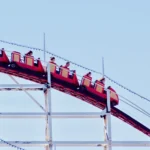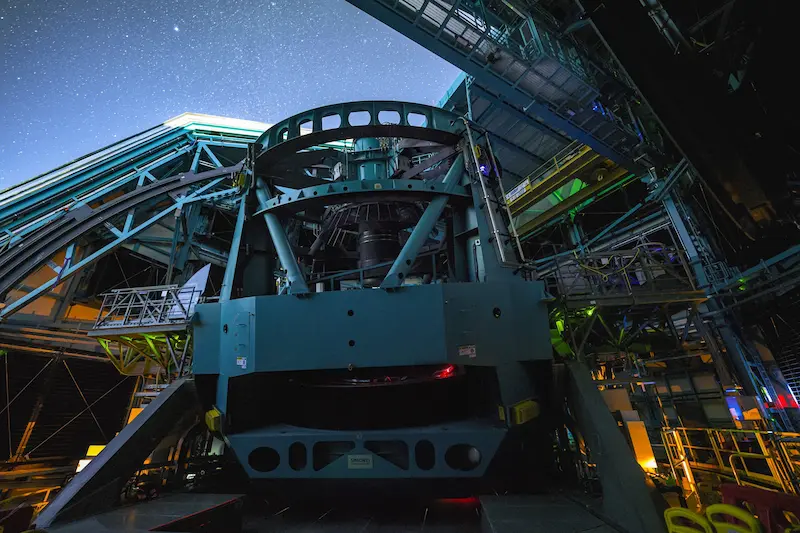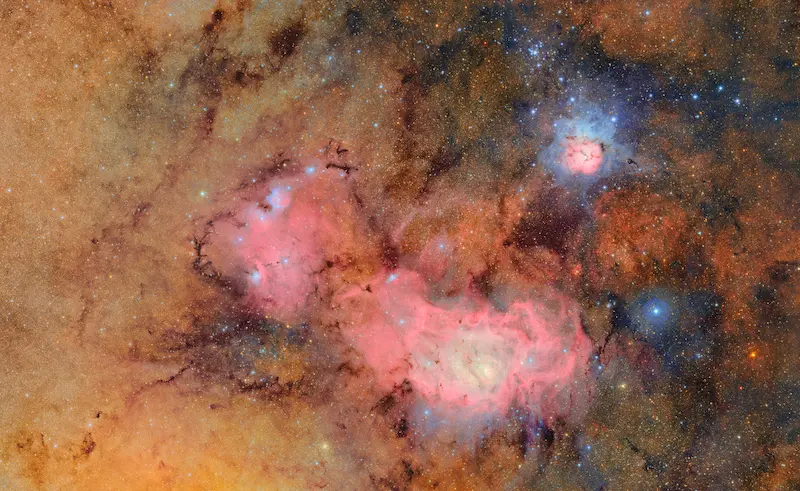
National Roller Coaster Day: The Science, History, and Engineering Thrills Behind the Ride
July 18, 2025
STEM Career Readiness: The Role of 3D Printing, Coding, and Robotics in the Classroom
September 1, 2025Scanning the Skies with the New Vera C. Rubin Observatory

The Vera C. Rubin Observatory against the night sky. https://noirlab.edu/public/images/iotw2207a/
A few months ago, after more than two decades of planning and construction, the Simonyi Survey Telescope opened its mighty cycloptic eye for the first time to gaze into the night sky – what astronomers refer to as a telescope’s “first light.” Then, just a few weeks ago on June 23rd, the Vera C. Rubin Observatory released the first few images produced by its revolutionary new telescope. And it’s set to transform the world of astronomy in the years to come.
Introduction to the Rubin Observatory
The Rubin Observatory sits majestically atop the peak of Cerro Pachón, a nearly 9,000-foot-high mountain in the Coquimbo Region of northern Chile. At this altitude, the air above the observatory is dry and cloudless, perfect for getting crisp, clear images of the cosmos.
Built by the National Science Foundation and the U.S. Department of Energy’s Office of Science, this $800 million observatory is named after the American astronomer of the same name, Vera C. Rubin, who pioneered the study of galaxy rotation rates in the 1970s and 80s. This groundbreaking research went on to serve as the first widely accepted evidence for the existence of dark matter and opened the doors to modern dark matter research.
Over the next 10 years, the Rubin Observatory’s mission will be to scan and map the sky of the Southern Hemisphere, piece by piece, over and over again, to conduct the most ambitious large-scale survey of the night sky in the history of astronomy.
The New Telescope on the Block

The Simonyi Survey Telescope, located at the Vera C. Rubin Observatory. https://rubinobservatory.org/gallery/collections/main-gallery/kt5oktm3h963n2ki8vnmvqjp4h
The real star of the show at the Rubin Observatory is the Simonyi Survey Telescope, a 350-ton, wide-field reflecting telescope with an 8.4-meter primary mirror. And at the heart of this telescope lies a 3-ton, 3.2-gigapixel CCD camera the size of a car – the largest digital camera ever made!
Using this camera and its unique three-mirror optical system, this telescope is able to capture the night sky with a field of view 45 times the size of the full moon! After collecting light from such an enormous patch of sky for a 30-second exposure, the telescope is able to shift position to capture the next patch of sky in as little as five seconds! And in the world of heavy, massive telescopes, that’s very fast.
At such a staggeringly fast rate of data collection, the Simonyi Survey Telescope is able to image the entire southern sky, from horizon to horizon, in only three days – a task that would take previous generations of telescopes months or even years to complete. And after the entire sky has been mapped, it’s back to starting line to do it all over again, creating a continuously growing, time-lapse “movie” of the night sky. This patchwork mosaic, recording the universe around us in both space and time, will allow scientists to not only probe the large-scale structure and evolution of the universe, but it will also allow scientists to study more transient phenomena, like the movement of asteroids within our solar system and explosive supernova events in distant galaxies.
Project scientists have dubbed this survey the Legacy Survey of Space and Time, or LSST for short (named as a homage to the original name of the observatory, the Large Synoptic Survey Telescope). Each night of observation is expected to increase the observatory’s data archive by a whopping 20 terabytes! And after just one year of operation, the Rubin Observatory will have collected more optical astronomy data than that produced by all previous telescopes combined. Yeah.
The Rubin Observatory and the Future of Astronomy

One of the first few images released by the Rubin Observatory. The image features the Trifid and Lagoon nebulae, a star-forming region around 9,000 lightyears from Earth. https://rubinobservatory.org/news/rubin-first-look/trifid-lagoon
The Rubin Observatory is expected to revolutionize the field of astronomy in a number of ways:
- The Dark Universe:
The Simonyi Survey Telescope at the Rubin Observatory is poised to radically innovate our study of the dark universe: the portion of our universe that is not directly observable using light. This includes both dark matter and dark energy, which collectively constitute about 95% of the universe. And we still aren’t sure what they really are. By studying the deep-sky data collected by the Rubin Observatory, astronomers and cosmologists will be able to better understand how dark matter and dark energy shape and influence the evolution of galaxies, galaxy clusters, and even what are known as “cosmic filaments,” the largest known structures in the universe. In particular, by studying the phenomenon of weak gravitational lensing, the Rubin Observatory is also expected to give us a better understanding of how dark matter is distributed around large galaxies. - Stellar Evolution and Orphan Stars:
One of the many mission objectives of the Rubin Observatory is to closely study the birth, life, and death of stars within and outside of our own galaxy, the Milky Way. Some scientists have even proposed using the Simonyi Survey Telescope to study faint intracluster light, i.e., light coming from “orphan stars” that reside between the galaxies within a galaxy cluster. - Heat Vision:
Using its infrared imaging capabilities and wide range of data collection, the images produced by the Rubin Observatory will likely play a large role in the discovery and study of dim objects like brown dwarfs and low-mass galaxies in the years to come. - Transient Phenomena:
Thanks to the repeated imaging of the southern sky by the Simonyi Survey Telescope and the resulting time-lapse nature of its data, the Rubin Observatory will prove to be an invaluable tool for detecting and tracking objects like asteroids and comets within our solar system, especially those that could potentially collide with our planet in the future. It may even be possible for the Rubin Observatory to detect undiscovered planets and dwarf planets lurking in the outer regions of our solar system, like the infamous “Planet Nine” suspected to orbit our Sun far beyond the orbit of Neptune. Further from home, this data will also allow scientists to track the behavior of pulsating variable stars as well as supernova events which could otherwise be missed by “one shot” telescopes. Each time something moves, changes brightness, or suddenly appears against the inky blackness of space, the Rubin Observatory is sure to detect it. In fact, the Simonyi Survey Telescope is expected to detect as many as 10 million of these sorts of transient events per night of observation!
Conclusion
By the end of its 10-year mission, the Rubin Observatory is expected to catalog more than:
- 5 million asteroids within our solar system
- 6 million “small solar system bodies” (objects like comets and minor planets)
- 17 billion stars
- 20 billion galaxies
To learn more about the Vera C. Rubin Observatory, check out this video from everyone’s favorite friendly neighborhood astrophysicist, Neil deGrasse Tyson. And for an even deeper dive into one of the first few images released by the observatory, check out this site (and be sure to click on the “Listen” link at the bottom of the page for some extra fun!). And classroom application ideas, be sure to check out this site created by the scientists at the Rubin Observatory.
Until next time.
– Dr. Jake Roark



